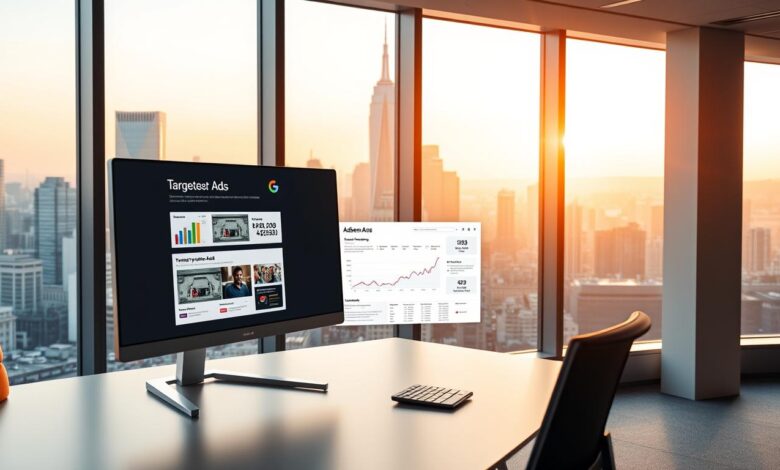
Increase Google AdSense Profits: Effective Tactics
Maximizing earnings from Google AdSense requires a strategic approach. To boost your online revenue, it’s essential to understand the tactics that drive success.

Effective tactics can significantly enhance your AdSense profits. By implementing the right strategies, you can optimize your website’s ad performance and increase your overall earnings.
Key Takeaways
- Optimize ad placement for maximum visibility
- Use relevant keywords to boost ad relevance
- Monitor and adjust ad performance regularly
- Improve user experience to increase engagement
- Utilize A/B testing to refine ad strategies
Understanding Google AdSense Fundamentals
To maximize Google AdSense revenue, it’s crucial to understand the underlying mechanics of how AdSense operates. Google AdSense is a powerful tool for publishers, but its effectiveness depends on various factors, including ad placement, user engagement, and the auction-based system it employs.
How the AdSense Auction and Bidding System Works
The AdSense auction system is a complex process where advertisers bid for ad space on publishers’ websites. This system ensures that the highest bidder’s ad is displayed, maximizing revenue potential for publishers. The bidding process involves various factors, including the advertiser’s bid amount, ad relevance, and user engagement metrics.
Key Metrics: CPC, RPM, CTR, and Fill Rate Explained
Understanding key metrics is vital for optimizing AdSense performance. CPC (Cost Per Click) measures the revenue generated per ad click, while RPM (Revenue Per Mille) estimates earnings per 1,000 page views. CTR (Click-Through Rate) indicates ad engagement, and Fill Rate measures the percentage of ad requests fulfilled. Monitoring these metrics helps publishers identify areas for improvement.
Setting Realistic Revenue Goals Based on Your Niche
Setting realistic revenue goals is essential for publishers. Niche selection plays a significant role in determining AdSense revenue potential. Publishers should research their niche’s average CPC, competition, and audience engagement to set achievable goals. By understanding these factors, publishers can develop strategies to boost their AdSense revenue.
By grasping these fundamentals, publishers can improve their AdSense performance and create a more effective monetization strategy.
Optimizing Your Website Structure for Maximum Earnings
The key to unlocking higher AdSense earnings lies in optimizing your website’s underlying structure. A well-optimized website not only improves user experience but also enhances AdSense monetization.
Site Speed Optimization Techniques for Better Ad Performance
Site speed is a critical factor in AdSense performance. Techniques such as compressing images, minifying CSS and JavaScript files, and leveraging browser caching can significantly improve your site’s loading speed.
- Use tools like Google PageSpeed Insights to identify areas for improvement.
- Optimize images without compromising quality.
- Minify and compress files to reduce load times.
Mobile-First Design Principles for Higher CTRs
Adopting a mobile-first design approach ensures that your website is accessible and user-friendly across all devices. This can lead to higher click-through rates (CTRs) and improved AdSense performance.
User Experience Factors That Directly Impact Ad Revenue
User experience plays a vital role in determining AdSense revenue. Factors such as clear navigation, engaging content, and non-intrusive ad placement contribute to a positive user experience, leading to higher ad revenue.
Strategic Ad Placement to Increase Visibility and Clicks
Boosting AdSense income involves optimizing ad placement for better visibility and clicks. Strategic ad placement is crucial for maximizing Google AdSense revenue. By understanding how to position ads effectively, publishers can significantly increase their earnings.
Heat Map Analysis for Optimal Ad Positioning
Using heat map analysis, publishers can identify the most engaging areas of their website. This tool visually represents user interactions, such as clicks and scrolls, helping to determine the best locations for ad placement. By placing ads in high-engagement areas, publishers can increase the likelihood of clicks and, consequently, their AdSense income.
Content-Integrated Ad Placement Strategies
Integrating ads seamlessly into content can improve user experience and increase ad effectiveness. This can be achieved by using native ads that match the form and function of the surrounding content. By doing so, publishers can create a more cohesive and engaging user experience, potentially leading to higher click-through rates.
Sidebar and Navigation Ad Optimization Techniques
Sidebar and navigation areas are prime real estate for ad placement. Optimizing these areas involves using the right ad formats and ensuring that ads are visible without being intrusive. Two effective techniques for optimizing these areas include:
- Sticky sidebar implementation
- Navigation menu ad integration
Sticky Sidebar Implementation
A sticky sidebar remains visible as the user scrolls down the page, providing continuous exposure to ads. This can be particularly effective for increasing ad visibility and clicks.
Navigation Menu Ad Integration
Integrating ads into the navigation menu can be an effective way to capture user attention. By placing ads in this prominent location, publishers can increase the likelihood of clicks.
By implementing these strategic ad placement techniques, publishers can enhance their AdSense earnings. The key is to balance ad visibility with user experience, ensuring that ads are seen and clicked without detracting from the overall user experience.
Selecting High-Performance Ad Formats and Sizes
To boost AdSense clicks, it’s crucial to select the right ad formats and sizes for your website. The choice of ad format and size can significantly impact your AdSense earnings, making it essential to understand which options work best for your content and audience.
Display vs. Text Ads: When to Use Each Format
Display ads are visually engaging and can include images, videos, or interactive elements. They are ideal for increasing brand awareness and can be effective for websites with high-quality visual content. On the other hand, text ads are simple, straightforward, and can be highly relevant to the content they accompany. They are particularly effective for websites with a strong focus on written content.
Key considerations:
- Use display ads for visually rich content or to promote specific products.
- Opt for text ads when your content is primarily text-based.
Top-Performing Ad Sizes by Device Type
Different devices respond better to different ad sizes. For desktop users, leaderboard ads (728×90) and medium rectangle ads (300×250) are often top performers. For mobile users, smaller formats like the responsive ad unit or the mobile leaderboard (320×50) tend to work well.
Top-performing ad sizes include:
- Desktop: 728×90 (Leaderboard)
- Mobile: 320×50 (Mobile Leaderboard)
- Both: 300×250 (Medium Rectangle)
Responsive Ad Units and Auto Ads Implementation Guide
Responsive ad units automatically adjust their size to fit different screen sizes and devices, ensuring a seamless user experience. Auto Ads, on the other hand, use machine learning to optimize ad placement across your website.
To implement responsive ad units:
- Choose the responsive ad unit format in your AdSense account.
- Copy the ad code and paste it into your website’s HTML.
For Auto Ads, simply enable them in your AdSense account and follow the setup instructions.
Content Strategies to Increase Google AdSense Profits
The key to unlocking higher AdSense profits lies in developing a well-thought-out content strategy. By focusing on high-quality, engaging content, publishers can significantly improve AdSense performance and enhance AdSense monetization.
Creating High-CPC Content in Lucrative Niches
To maximize AdSense earnings, it’s crucial to create content in lucrative niches that attract high-paying advertisers. This involves understanding your audience and crafting content that resonates with them, thereby increasing the likelihood of higher CPC (Cost Per Click) ads being displayed on your site.
Keyword Research Methods for AdSense Optimization
Effective keyword research is the foundation of any successful AdSense strategy. By identifying relevant, high-traffic keywords, publishers can optimize their content to attract more valuable ads. Tools like Google Keyword Planner and SEMrush can be invaluable in this process.
Content Length, Quality, and Engagement Factors
The length, quality, and engagement factors of your content play a significant role in AdSense performance. High-quality, engaging content not only attracts more readers but also encourages them to click on ads, thereby improving AdSense performance.
Long-Form vs. Short-Form Content Performance
There’s ongoing debate about whether long-form or short-form content performs better in terms of AdSense earnings. While long-form content can provide more opportunities for ad placement, short-form content can be more engaging and lead to higher CTR (Click-Through Rate).
Multimedia Integration for Higher Engagement
Incorporating multimedia elements such as videos, images, and infographics can significantly enhance user engagement. By making your content more interactive and visually appealing, you can increase the time users spend on your site, thereby enhancing AdSense monetization.
In conclusion, a well-crafted content strategy is essential for maximizing Google AdSense profits. By focusing on high-CPC content, effective keyword research, and enhancing engagement through multimedia integration, publishers can significantly improve their AdSense earnings.
Audience Targeting for Premium Advertisers
To maximize AdSense profits, understanding and targeting the right audience is essential. By doing so, publishers can attract premium advertisers willing to pay higher CPCs.
Demographic Analysis for Better Ad Matching
Understanding your audience’s demographics is crucial for matching them with relevant ads. Analyze metrics such as age, gender, and interests to create a comprehensive profile.
- Use Google Analytics to gather demographic data about your audience.
- Analyze user behavior to understand their interests and preferences.
Geo-Targeting Strategies for Higher-Paying Markets
Geo-targeting allows you to focus on specific geographic regions, potentially increasing ad revenue. Target high-paying markets by understanding the geographical distribution of your audience.
- Identify regions with high advertiser demand.
- Adjust your content to appeal to these regions.

Custom Channels and Ad Unit Categorization
Custom channels and ad unit categorization help in organizing and optimizing ad performance. By categorizing ad units, you can analyze performance and make data-driven decisions.
- Create custom channels for different ad units or categories.
- Monitor performance and adjust strategies accordingly.
By implementing these audience targeting strategies, publishers can optimize their AdSense ads and potentially increase their AdSense CPC, leading to higher earnings.
Technical Optimization Tactics for Better Ad Performance
To boost AdSense revenue, implementing technical optimization tactics is essential. Technical optimization plays a critical role in ensuring that your website’s ads perform at their best, thereby maximizing your AdSense earnings.
Ad Block Detection and Recovery Solutions
Ad block detection is a crucial strategy for recovering revenue lost to ad blockers. By detecting when a user is blocking ads, you can implement recovery solutions such as asking users to disable their ad blockers or offering premium content in exchange for ad viewing.
According to a study, ad blockers cost publishers billions of dollars annually. Implementing ad block detection can help mitigate this loss.
Lazy Loading Implementation for Better Page Performance
Lazy loading is a technique that defers the loading of non-essential resources, such as ads, until they are needed. This can significantly improve page load times and enhance user experience.
By implementing lazy loading for your ads, you can improve your website’s performance and potentially increase your AdSense revenue.
Browser and Device-Specific Optimizations
Optimizing your ads for different browsers and devices is vital for maximizing your AdSense earnings. This includes ensuring that your ads are responsive and perform well across various screen sizes and devices.
Mobile Ad Delivery Optimization
With the majority of web traffic coming from mobile devices, optimizing your ads for mobile is crucial. Ensure that your ad units are responsive and load quickly on mobile devices to improve user experience and AdSense revenue.
Cross-Browser Testing Protocols
Cross-browser testing is essential for ensuring that your ads perform well across different browsers. Regularly test your ads on various browsers to identify and fix any issues that may be impacting your AdSense earnings.
| Optimization Technique | Description | Benefit |
|---|---|---|
| Ad Block Detection | Detecting and recovering revenue lost to ad blockers | Revenue Recovery |
| Lazy Loading | Deferring the loading of non-essential resources | Improved Page Performance |
| Browser and Device Optimization | Optimizing ads for different browsers and devices | Maximized AdSense Earnings |
By implementing these technical optimization tactics, you can significantly improve your AdSense performance and grow your AdSense income.
Analytics and Performance Tracking Systems
To improve AdSense earnings, a deep dive into analytics is necessary. By understanding and leveraging the right analytics tools, publishers can significantly enhance their AdSense performance and maximize earnings.
Essential AdSense Reports for Revenue Optimization
AdSense provides a variety of reports that are crucial for optimizing revenue. The Performance Reports offer insights into earnings, clicks, and impressions over time, allowing publishers to identify trends and areas for improvement.
Another vital report is the Ad Unit Performance report, which helps in understanding how different ad units are performing. This information can be used to optimize ad placements and formats for better performance.
Google Analytics Integration for Audience Insights
Integrating Google Analytics with AdSense provides a more comprehensive view of audience behavior and ad performance. By analyzing metrics such as bounce rate, session duration, and user demographics, publishers can gain valuable insights into their audience.
This integration enables publishers to make data-driven decisions to enhance user engagement and, consequently, improve AdSense earnings.
Setting Up Performance Alerts and Benchmarks
Setting up performance alerts in AdSense and Google Analytics helps publishers stay informed about significant changes in their ad performance. These alerts can be configured to notify publishers of unusual activity, such as a sudden drop in earnings or an increase in click-through rates.
Benchmarking performance against industry averages or competitors can also provide insights into areas that need improvement. By regularly monitoring these metrics, publishers can adjust their strategies to optimize AdSense performance.
A/B Testing Methodologies to Maximize Revenue
To optimize AdSense ads and enhance monetization, publishers must adopt a systematic A/B testing strategy. A/B testing, also known as split testing, allows publishers to compare two or more versions of an ad or webpage to determine which one performs better.
Systematic Ad Size and Format Testing
Testing different ad sizes and formats is crucial to identifying the most effective configurations. By experimenting with various ad sizes, such as display, text, or link units, publishers can determine which formats yield the highest click-through rates (CTRs) and conversion rates.
| Ad Size | CTR | CPC |
|---|---|---|
| 300×250 | 0.5% | $0.50 |
| 728×90 | 0.8% | $0.80 |
| 320×100 | 0.3% | $0.30 |
Color Scheme and Style Experimentation Techniques
The color scheme and style of ads can significantly impact their performance. By testing different color combinations and ad styles, publishers can identify the most effective designs that resonate with their audience.

Ad Density and Placement Testing Frameworks
Ad density and placement are critical factors in determining AdSense revenue. By testing different ad densities and placements, publishers can identify the optimal configurations that balance revenue goals with user experience.
By applying these A/B testing methodologies, publishers can enhance their AdSense monetization and optimize their ad strategies to achieve better performance and higher revenue.
Advanced Monetization Strategies Beyond Basic AdSense
To boost AdSense clicks and overall revenue, publishers must adopt sophisticated monetization strategies. While basic AdSense setup is straightforward, there’s a wealth of advanced techniques that can significantly enhance earnings.
Combining AdSense with Affiliate Marketing
One effective strategy is combining AdSense with affiliate marketing. By promoting relevant products or services, publishers can earn commissions while still displaying AdSense ads. This dual approach can increase Google AdSense profits by maximizing the revenue potential of their content.
Affiliate marketing involves partnering with brands to promote their products. When a visitor clicks on an affiliate link and makes a purchase, the publisher earns a commission. This can be particularly lucrative in niches with high-demand products.
| Strategy | Description | Potential Revenue Impact |
|---|---|---|
| AdSense + Affiliate Marketing | Combining AdSense ads with affiliate links in content | High |
| Seasonal Optimization | Adjusting ad strategies based on seasonal trends | Medium to High |
| Premium Traffic Sources | Leveraging high-quality traffic sources for better CPCs | High |
Seasonal and Trend-Based Optimization Techniques
Adapting to seasonal trends and optimizing ad strategies accordingly can significantly impact AdSense revenue. For instance, during holiday seasons, advertisers often increase their budgets, leading to higher CPCs.
Publishers can capitalize on this by creating content that aligns with current trends and holidays, thereby attracting higher-paying ads. Trend-based content creation not only boosts AdSense earnings but also enhances the site’s relevance and appeal to visitors.
Leveraging Premium Traffic Sources for Higher CPCs
Attracting high-quality traffic is crucial for achieving higher CPCs and, consequently, boosting AdSense clicks. Premium traffic sources include social media platforms, email newsletters, and high-authority referral sites.
Social Media Traffic Optimization
Social media can be a powerful tool for driving traffic to a site. By creating engaging content that resonates with their audience, publishers can attract visitors who are more likely to click on ads.
Email Newsletter Integration Strategies
Email newsletters offer a direct line to subscribers, allowing publishers to promote their content and ads. By integrating AdSense-friendly content into newsletters, publishers can drive targeted traffic to their sites, potentially increasing ad clicks.
By implementing these advanced monetization strategies, publishers can significantly enhance their AdSense earnings. It’s about diversifying revenue streams, optimizing for trends, and leveraging premium traffic sources.
Common Mistakes That Significantly Reduce AdSense Earnings
Common errors can drastically cut into AdSense profits, making it essential to identify and avoid them. To improve AdSense performance and grow AdSense income, publishers must be aware of the pitfalls that can negatively impact their earnings.
Policy Violations That Risk Account Suspension
One of the most significant mistakes AdSense publishers make is violating Google’s policies. This can include clicking on their own ads, encouraging others to do so, or placing ads on pages with prohibited content. Such violations can lead to account suspension, resulting in a complete loss of income.
Ad Placement Errors That Hurt Performance
Incorrect ad placement can significantly reduce earnings. Placing ads in locations where they are not visible or are irrelevant to the content can lead to low click-through rates (CTR) and cost-per-click (CPC). It’s crucial to place ads in strategic locations where they are most likely to be seen and clicked.
Content Quality Issues That Lower Ad Value
Producing low-quality content can lower ad value and reduce AdSense earnings. Thin content, plagiarized content, or content not relevant to the ads can lead to lower CPC and RPM. Ensuring that your content is high-quality, engaging, and relevant is vital.
| Common Mistake | Impact on AdSense | Solution |
|---|---|---|
| Policy Violations | Account Suspension | Comply with Google’s Policies |
| Poor Ad Placement | Low CTR and CPC | Strategic Ad Placement |
| Low-Quality Content | Lower Ad Value | Create High-Quality Content |
Conclusion: Sustainable Strategies for Long-Term AdSense Success
To maximize AdSense earnings, it’s crucial to continually optimize and adapt your strategies. By implementing the tactics outlined in this article, you can enhance AdSense monetization and achieve long-term success.
Effective AdSense optimization involves a combination of strategic ad placement, high-performance ad formats, and content strategies that attract premium advertisers. Regularly reviewing your performance data and making data-driven decisions is key to maintaining and growing your earnings.
By focusing on sustainable strategies, such as continually testing and refining your ad placements, improving your website’s user experience, and creating high-quality, engaging content, you can ensure the long-term success of your AdSense endeavors.
FAQ
What are the most effective ways to increase Google AdSense profits?
To boost AdSense earnings, focus on optimizing your website structure, strategic ad placement, and creating high-quality, engaging content that attracts premium advertisers and increases CPC.
How can I optimize my website for better AdSense performance?
Improve your website’s speed, adopt a mobile-first design, and prioritize user experience to enhance AdSense performance. Additionally, use heat map analysis to optimize ad placement and experiment with different ad formats and sizes.
What are the best ad formats and sizes for maximizing AdSense earnings?
The most effective ad formats and sizes vary by device type. Use responsive ad units and Auto Ads to optimize ad performance. Display ads and text ads have different use cases, and choosing the right format depends on your content and audience.
How can I increase my AdSense CPC and revenue?
To increase CPC, focus on creating high-CPC content in lucrative niches, leveraging premium traffic sources, and targeting high-paying markets through geo-targeting strategies. Also, optimize your ad placement and formats to improve CTR and earnings.
What are some common mistakes that can reduce AdSense earnings?
Policy violations, ad placement errors, and content quality issues can significantly reduce AdSense earnings. Avoid these mistakes by following AdSense policies, optimizing ad placement, and creating high-quality, engaging content.
How can I track and analyze my AdSense performance?
Use essential AdSense reports, Google Analytics integration, and set up performance alerts and benchmarks to track and analyze your AdSense performance. This will help you make data-driven decisions to optimize your AdSense earnings.
What is A/B testing, and how can it help maximize AdSense revenue?
A/B testing involves systematically testing different ad sizes, formats, color schemes, and placement strategies to identify the most effective approaches. By applying A/B testing methodologies, you can optimize your AdSense monetization and maximize revenue.
How can I leverage advanced monetization strategies beyond basic AdSense?
Combine AdSense with affiliate marketing, leverage seasonal and trend-based optimization, and use premium traffic sources to diversify your income streams and maximize AdSense profits. Also, consider social media traffic optimization and email newsletter integration strategies.



